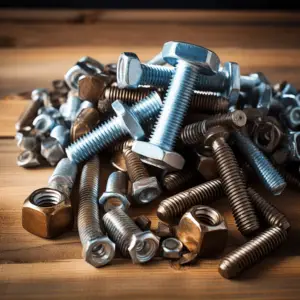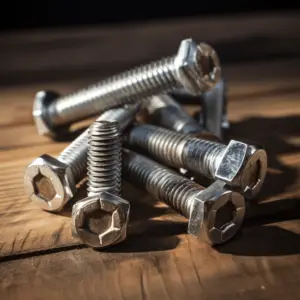Lag Bolts and Carriage Bolts, For DIY homeowners and property owners alike, choices are almost endless when it comes to different types of bolts and screws to use for their projects.
Sometimes you might need several types of fasteners, especially when working on elaborate projects such as decks, sheds, children’s play areas, etc. Fortunately, there are many different types of bolts and screws that can be used for a variety of projects.
While you don’t want to build an entire structure, and then find out that you’ve used the wrong bolts, understanding the difference between these types of hardware is crucial. It can greatly improve your efficiency and help complete your project the proper way.
But what’s the difference between Lag Bolt Vs Carriage Bolt?

Well, first up, both options have a major variation in shape. The application itself is quite distinct. Even in construction, these types of hardware are utilized in separate kinds of work. And lastly, you’ll have to consider the cost and availability of each. Here’s a quick review.
Lag Bolt
Lag bolts, often referred to as lag screws, are tough bolts used to attach pieces of wood together in load-bearing applications such as decks and barns. Although they’re very similar to an ordinary screw, lag bolts are longer and incredibly tough, and only a part of the shaft is threaded.
With the pointed threaded portion, hexagonal head and round neck, lag bolts can be screwed directly into the wood without the need to make a hole.
You also don’t have to use a nut and washer, as in the case with carriage bolts because the partial threading allows you to adjust the screw to match the application. Perhaps that’s why they’re commonly used to add extra strength in construction.
Lag bolts are available in various types of materials, but stainless steel is the most common. You’ll also find that most of these bolts are usually three to six inches in length.
Carriage Bolt
Carriage bolts are just another type of common fastener that is used in different large constructions. It is usually used with a flat washer and they are available in a variety of sizes and diameters.
They have a cylindrical threaded portion, domed head, and square neck and are typically stronger and can handle a higher weight capacity.
Lag Bolt vs. Carriage Bolt: Detailed Comparison
To better understand both options, we have discussed all the differences between them. Note that different types of fasteners have their own types of functions that they’re meant to perform. That means a deck screw is not going to work adequately for putting up drywall.
When it comes to lag bolts and carriage bolts, people often get them confused or classify them as the same. Yet, they are different in many ways:
The shape of the Bolts
Both bolts are very different in shape. With a lag bolt, you’ll find a pointed threaded portion, hexagonal head, and round neck. Some people refer to them as lag screws, because they look more like a screw than a bolt.
On the other hand, carriage Bolts have a domed head, a square neck, and an entire threaded portion in the shape of a cylinder. Carriage bolts are also referred to as plow bolts.
Application
As mentioned before, both lag bolt and carriage bolt are used for construction, but the variation comes in the way they are used.
The fact that the lag bolt has a pointed end means it can be directly drilled or twisted on. You won’t have to make a whole separately to insert these, which makes them comparatively easier to work with.
Carriage bolts, on the other hand, are often used as common fasteners. They have a flat end and as a result, they have to be used with a flat washer. Due to their shape, you will have to make a whole separately to put it in, which is a little more work compared to lag bolts.
On the bright side, their shape will help better fasten your surfaces together. For instance, you can use them to create outdoor structures such as carports or pergolas. Just be sure to remember the washer and nut, because, without these, the carriage bolt won’t function properly.
Strength of the Bolts
For any type of construction, it’s important to ensure all bits and pieces are secured properly. It will help to ensure the safety of the finished project.
Although lag bolts are often considered great for attaching heavy wood structures, they simply don’t have the capacity or the strength that other options do. This is probably because they’re not meant for use with an added washer and nut. Thus, they don’t have the much-needed weight capability.
Carriage bolts, on the other hand, do have an upper hand, given that they are attached with fasteners. This provides the much-needed support to your structure, making them ideal to withstand large amounts of weight. Plus, you can tighten them according to your needs.
Depending on the lag bolt’s grade and area of application, la bolts can withstand up to thousands of pounds. The commercial-grade 8 bolts are typically the strongest options, but generally, the shear strength of carriage bolts tends to be relatively high.
How to Choose the Right Bolt for a Project

Now that we have discussed the differences between these two bolt types, it’s also important to understand which bolt is going to serve the best in your project. There are a few basic factors you need to consider before deciding on the proper bolt for the job:
Application
This is perhaps the most important factor in knowing what bolt will work best in your project. Are you going to use the bolt outside? Is it for a lightweight job or do you want it for a weight-bearing project?
You can ideally look for similar projects to the one you’re planning to work on and use the same bolts on your specific project. This will help to determine whether you need threaded rods or you need something to use with washers and nuts.
Material of the Screw or Bolt
The material that the bolt or the screw is made of can greatly impact the strength of your project. This kind of hardware comes with different grades, where 2 and 8 are the lowest and highest grades respectively.
Grade 8 bolts are likely to be stronger than grade 2 because they are produced through a much more difficult process. The best material for you will depend on the task at hand. Some bolts and screws are made of brass or bronze, while others are made of stainless steel.
Lag Bolts and Carriage Bolts important to consider the ability of the material to hold up in certain conditions. For instance, some materials do well in the heat and others work best in outdoor situations.
Size
The size of the bolt is yet another important thing to consider as some bolts are available in large sizes than others. You also have to determine how much of the bolt will need to be threaded and the type of cap you want on the bolt.
The Final Word
Now that you have a detailed comparison of lag bolt vs. carriage bolt, you can choose one for your next project. Both bolts are similar for the most part, but it’s important to understand the differences and the limitations that each one has. In the end, you don’t want to have an incomplete project or something that is not sturdy enough.
